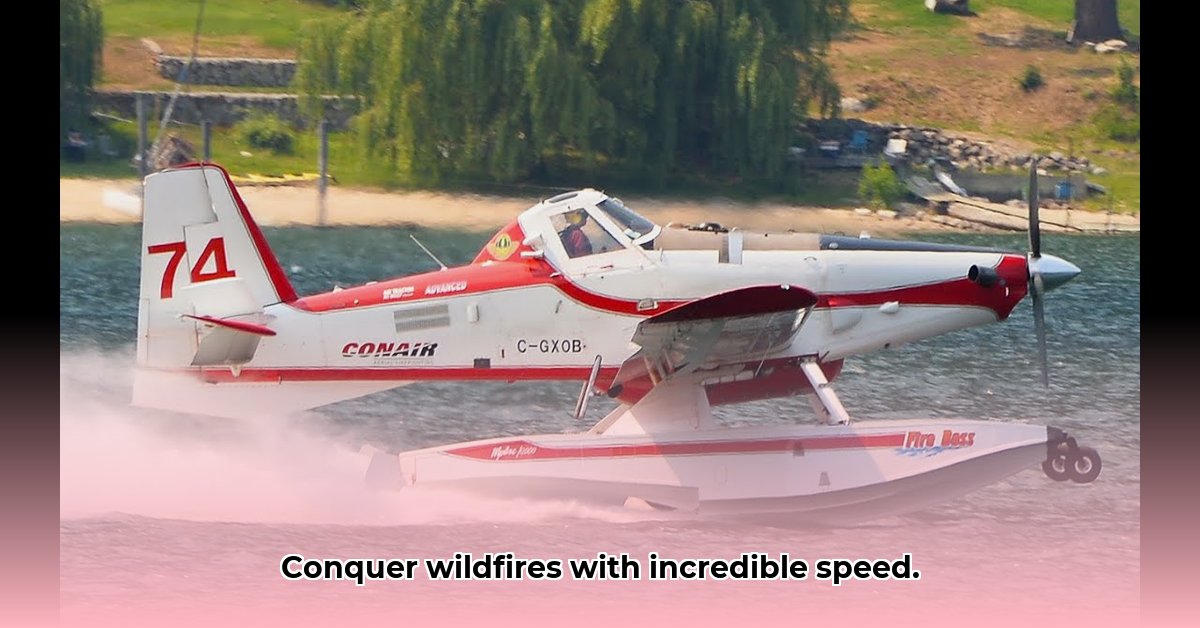
The Air Tractor AT-802A Fire Boss is a specialized amphibious aircraft designed for rapid wildfire suppression. Its speed, agility, and unique water-scooping capabilities make it a crucial tool in combating rapidly spreading wildfires. But how does this aircraft achieve such rapid response times, and what are its limitations? This article delves into the technical details and operational strategies surrounding this vital firefighting asset. For more in-depth information, check out this detailed resource on the Fire Boss.
Performance and Capabilities
The AT-802A Fire Boss distinguishes itself through its remarkably fast water scooping ability—a crucial advantage in dynamic wildfire situations. It can fill its tanks in as little as 30 seconds, allowing for quick turnaround between water drops. This rapid refill rate, coupled with a powerful engine minimizing warm-up time, enables the aircraft to conduct multiple water drops in rapid succession. This rapid response capability is often the critical factor in containing a small fire before it escalates into a major disaster. Isn't efficient fire suppression dependent on speed and quick reaction time?
Beyond its speed, remarkable maneuverability sets the Fire Boss apart. Its agility allows it to operate in challenging terrains and confined spaces where larger air tankers would struggle. This precision control is imperative for accurate water placement, maximizing efficiency and minimizing water waste. This is particularly vital in urban-wildland interface environments where precise water drops around structures are necessary.
The Fire Boss's versatility further enhances its value. Pilots can adjust water or retardant drop patterns to suit diverse firefighting needs. This adaptable technology allows the plane to effectively tackle a wide array of fire situations, from large-scale blanket coverage to highly targeted drops on intense heat zones. Optional foam tanks provide an additional layer of fire suppression capability.
Limitations and Operational Considerations
While the AT-802A Fire Boss boasts exceptional strengths, it also has limitations. Its smaller water payload compared to larger air tankers means fewer gallons per drop. However, its rapid refill rate significantly compensates for this. The aircraft's high speed, while crucial for fast response, also results in higher fuel consumption. This requires careful flight planning to optimize fuel efficiency and mission duration.
Another crucial aspect is range and fuel efficiency. Mission planning must carefully consider the distances between the water source and the fire, factoring in fuel consumption. The operational range dictates the effective distance from a base of operations the Fire Boss can function before requiring refueling. Balancing rapid water drops with efficient fuel consumption is critical for maximizing the plane's effectiveness.
Stakeholder Collaboration and Technological Advancements
Effective wildfire fighting requires a collaborative effort. Firefighting agencies need to assess the AT-802A's capabilities in relation to their specific needs and fire risk profiles. Does the aircraft’s speed and agility align with their typical fire scenarios? Do their existing infrastructure and operational parameters allow for effective deployment? This careful analysis helps agencies determine if the Fire Boss is the optimal tool for their needs.
Manufacturers continuously strive to improve the aircraft's performance. Ongoing developments focus on better foam tank integration and exploring more fuel-efficient engine options, including potential hybrid-electric propulsion to further minimize environmental impact. Comprehensive pilot and ground crew training, particularly in amphibious operations, is crucial for safe and effective utilization of the aircraft’s full potential.
Safety and Regulatory Compliance
Safety is paramount in firefighting operations. A robust risk assessment is crucial, encompassing potential failure points and their impact:
| Technology/System | Likelihood of Failure | Impact of Failure | Mitigation Strategies |
|---|---|---|---|
| Engine (PT6A-67F) | Low | High | Rigorous maintenance, backup systems. |
| Amphibious Floats | Medium | High | Frequent inspections, robust emergency systems. |
| Water Scooping System | Medium | Medium | Redundant systems, operator training, proactive maintenance. |
| Delivery System | Low | Medium | Regular calibrations, system monitoring. |
Adherence to all relevant aviation regulations is non-negotiable. This involves complying with water collection safety guidelines, emergency procedures, and environmental regulations concerning water and retardant usage. Staying updated on the ever-evolving regulatory landscape is critical for safe and legal operations. How can agencies ensure consistent compliance across their fleet of Fire Bosses?
Optimizing Fuel Efficiency for Extended Operations
The AT-802 Fire Boss's speed and payload, while strengths, contribute to a high fuel burn rate. Extended operations demand careful fuel management. How can we improve its efficiency without compromising its effectiveness?
Strategies for Enhanced Fuel Efficiency
Several strategies can improve fuel economy:
- Route Optimization: Plan the shortest routes, reducing unnecessary maneuvers.
- Altitude and Airspeed Management: Maintain optimal altitude and airspeed, considering that high speeds significantly increase fuel consumption.
- Load Management: Carry only the necessary water or retardant. Overloading diminishes efficiency and range.
- Weather Considerations: Adapt flight plans to account for strong winds and turbulence, which can substantially increase fuel consumption. Consider delaying flights in truly severe weather conditions.
Technological and Operational Improvements
Technological advancements and improved operational practices are essential:
- Gen III FRDS: This advanced system allows for precise water/retardant drops, reducing the number of passes needed and consequently fuel consumption.
- Data Analytics: Real-time data on fuel consumption and environmental factors enables pilots and operators to make more efficient strategic adjustments.
- Preventative Maintenance: Regular maintenance keeps the aircraft performing optimally.
- Engine Tuning: A well-tuned engine operates more efficiently, reducing fuel waste.
- Aerodynamic Integrity: Maintaining the cleanliness and structural integrity of the aircraft's aerodynamic surfaces is vital for fuel efficiency.
- Pilot Training: Advanced training focused on fuel-efficient techniques and crew coordination maximizes efficiency and minimizes fuel waste.
Future advancements in engine technology, potentially including hybrid-electric propulsion, promise further substantial improvements in fuel efficiency for the AT-802A Fire Boss. The ongoing development and refinement of both the aircraft and operational strategies will be pivotal in maximizing its effectiveness in the fight against wildfires.